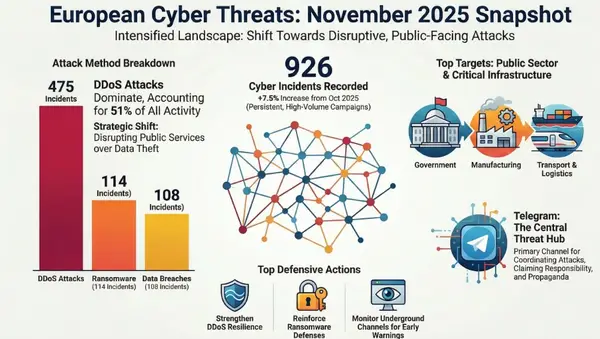The Unseen Frontlines: Navigating the Intertwined Threats of AI Incidents, Disinformation, and Cyber Espionage

In today's rapidly evolving digital landscape, organizations and individuals face a complex web of threats that are increasingly interconnected. This article delves into three critical areas – artificial intelligence (AI) incidents, sophisticated disinformation campaigns, and malicious cyber espionage – drawing on recent intelligence and research to illuminate their nature, impact, and the crucial need for proactive understanding and robust defense strategies.
The Shadowy World of Disinformation: The Doppelgänger Example
Recent analysis has shed light on the persistent threat posed by disinformation campaigns, exemplified by the activities of the intrusion set known as Doppelgänger. This threat actor engages in large-scale operations that involve impersonating well-respected media outlets across various targeted countries, including France, Germany, Italy, Ukraine, and Israel.
Doppelgänger's tactics are sophisticated, utilizing digital replicas of media interfaces hosted on typosquatted domains to deceive internet users. These fake articles are then amplified on social media platforms like X (formerly Twitter) through bot accounts specifically created for this purpose. The aim of these campaigns is clear: to manipulate public opinion by exploiting sensitive issues and exacerbating existing social and geopolitical divisions.
The narratives propagated by Doppelgänger are carefully tailored to each target country:
- France: Key narratives include anti-Western and anti-American sentiments, portraying the US as exploitative. Another prominent narrative focuses on the alleged decline of France under President Macron, alongside efforts to undermine support for Ukraine by spreading claims of Ukrainian corruption and the futility of Western aid. The campaign also touched on anti-vaccination narratives and aimed to diminish French influence in Africa. Linguistic analysis suggests that many of these articles are likely translated from Russian or edited by Russian natives, pointing towards their origin.
- Germany: Disinformation efforts here centered on economic failure in Germany, aiming to polarize the public against the coalition government. Another key narrative linked migration policies to Germany's economic and social woes, while also undermining support for Ukraine by portraying it as corrupt and aid as ineffective. While linguistic clues weren't as pronounced as in the French campaign, the use of awkward phrasing and poor localization hinted at non-native German authorship.
- Italy: In a surprising deviation from their usual tactics, Doppelgänger appears to have amplified narratives on a real blog/forum called "FarodiRoma", known for its pro-Russian stance and criticism of NATO. The main narrative identified focused on underestimating Ukrainian military losses, using unverified data and questionable methodologies to support this claim.
- Ukraine: The campaign in Ukraine involved impersonating media outlets like UNIAN and Obozrevatel to spread narratives aimed at weakening morale and fostering the perception of an inevitable military collapse. Key narratives included the idea of waning international support, Ukrainian corruption as a major obstacle, a disorganized military, and the promotion of peace through territorial concessions.
- Israel: The narratives targeting Israel, impersonating Walla, focused on the idea that the Democratic Party's failures are weakening Israel and empowering its adversaries. Other narratives claimed that the United States is fostering anti-semitism and that economic struggles in Israel are caused by the war and Western inaction.
To bypass moderation on social media, Doppelgänger continues to utilize services like Kehr[.]io, a redirection provider advertised on Russian-speaking underground forums. This infrastructure often relies on bulletproof hosting providers that are known for their resilience to takedowns and their willingness to host malicious content. Investigations have linked Doppelgänger's infrastructure to various entities, including Partner Hosting LTD, WAICORE LTD, and infrastructure previously associated with individuals like Daniil Yevchenko. These networks often utilize shell companies and offshore organizations to obscure their operations.
The Persistent Threat of Cyber Espionage: UAC-0050 and UAC-0006
Beyond disinformation, the cyber landscape is constantly challenged by espionage-motivated threat actors. Two prominent Russia-aligned intrusion sets, UAC-0050 and UAC-0006, continue to actively engage in financially and espionage-motivated spam campaigns. Their primary focus in early 2025 was on Ukrainian entities, including governmental bodies and critical companies operating in the defense, energy, and gas industries. They have also targeted journalists covering the war in Ukraine and Ukrainian branches of NGOs involved in the conflict. International companies with interests in Ukraine have also been targeted.
UAC-0006 is primarily financially motivated, targeting accountants' computers with phishing emails containing SmokeLoader malware, which can facilitate unauthorized access to financial systems. UAC-0050 operators are known for creating unauthorized payments, sometimes using HVNC bots directly from compromised machines.
Both intrusion sets heavily rely on bulletproof hosting providers to maintain their infrastructure, frequently moving through different networks and establishing new front companies to evade detection. Analysis of their infrastructure has revealed the use of IPs from Global Connectivity Solutions LLP (AS215540), a UK-based entity with officers linked to Zservers, a Russian bulletproof hosting provider sanctioned for supporting ransomware attacks. They also leverage other networks like those associated with Nechaev Dmitry Sergeevich (AS213194) and Railnet LLC (AS214943), which act as legal fronts for bulletproof hosting services like Virtualine. These providers openly advertise their services on underground forums, explicitly mentioning their suitability for illicit activities.
The tactics employed by these groups often involve phishing emails with malicious attachments (like RAR or ZIP archives containing LNK files, VBS scripts, or executables) or links leading to malware hosted on platforms like Bitbucket or compromised websites. The final payloads often include remote access trojans (RATs) such as Remcos, LiteManager, and NetSupport Manager, as well as information stealers like Lumma Stealer and Mars Stealer.
The Emerging Threat of AI Incidents: A Call for Reporting
While disinformation and cyber espionage represent established and evolving threats, the increasing integration of artificial intelligence (AI) into various aspects of life introduces a new category of risk: AI incidents. These incidents, defined as events where the development, use, or malfunction of AI systems directly or indirectly leads to harm, are occurring with wide-ranging adverse impacts.
Currently, systematic and comprehensive reporting of AI incidents is lacking. Most existing databases rely on news reports and publicly available information, leading to potential gaps in understanding the true scope and nature of these events. To address this critical gap, a federated, comprehensive, and standardized AI incident reporting framework is urgently needed.
Key components proposed for a mandatory AI incident reporting regime include:
- Type of event: Whether harm occurred (incident) or nearly occurred (near miss). Reporting near misses is crucial as they can reveal vital conditions that prevented harm.
- Type of harm: Categorizing the nature of the harm, such as physical, environmental, economic and financial, reputational, public interest, or violations of human and fundamental rights.
- Mechanism of harm: Capturing the contributing factors, including technical factors (system vulnerabilities, model drift) and other factors (human and contextual factors, misuse).
- Severity factors: Data essential for assessing the severity of the impact, which is crucial for prioritizing mitigation efforts.
- Technical data: Requiring the submission of AI system cards, AI model cards, and datasheets to capture vital technical dimensions of the AI systems involved.
- Context and circumstances: Information about the AI's purpose, sector of deployment, timelines, location, reporting entity, and any existing safeguards and policies.
- Entities and individuals: Details of the AI actors (provider, operator, deployer) and affected stakeholders (users or nonusers).
- Post-incident data: Including the incident response actions taken and an ethical impact assessment.
Drawing lessons from incident reporting practices in sectors like transportation, healthcare, and cybersecurity can significantly enhance the development of effective AI incident reporting guidelines. These sectors emphasize the collection of contextual information, technical data, and, in the case of healthcare and transportation, near misses and details about existing safeguards. They also often utilize frameworks for assessing the severity of incidents.
The widespread adoption of standardized AI incident reporting components by governments, regulators, developers, and researchers can lead to numerous benefits, including:
- Facilitating consistent data collection of AI incidents.
- Promoting tracking, monitoring, research, and information sharing.
- Enhancing knowledge around AI-related harms and risks.
- Ensuring that essential data is collected to prevent reporting gaps.
- Building a foundational framework for agile incident reporting that adapts to AI advancements.
To fully realize these benefits, it is recommended to publish mandatory AI incident reporting formats based on these key components and to establish an independent investigative agency to uncover incident data that may not be immediately discernible.
Conclusion: An Interconnected Threat Landscape Demands a Holistic Approach
The information presented highlights the interconnected nature of the threats we face in the digital age. Disinformation campaigns, like those orchestrated by Doppelgänger, leverage sophisticated techniques and infrastructure to manipulate public opinion and sow discord. Simultaneously, cyber espionage groups like UAC-0050 and UAC-0006 persistently target critical infrastructure and individuals for espionage and financial gain, relying on similar shadowy networks of bulletproof hosting providers.
The emergence and increasing sophistication of AI introduces a new dimension to this threat landscape. Understanding and effectively mitigating the risks associated with AI incidents requires a concerted effort towards systematic reporting and analysis. By learning from established incident reporting practices in other critical sectors and adopting a standardized framework for AI incidents, we can enhance our knowledge of AI-related harms and develop more robust safety and security measures.
Ultimately, navigating these interconnected threats demands a holistic security approach. Organizations and governments must invest in threat intelligence capabilities to understand the tactics and infrastructure of actors involved in disinformation and cyber espionage. Simultaneously, they must proactively engage in the development and implementation of AI incident reporting mechanisms to ensure the safe and responsible deployment of artificial intelligence. By recognizing the unseen frontlines where these threats converge, we can better protect our digital infrastructure, our information integrity, and our societal well-being.





